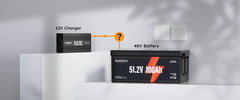
Can I Charge a 48V Battery With a 12V Charger?
, 5 min reading time


, 5 min reading time
Many DIY solar builders, RV campers, and off-grid users eventually ask the same question:
“Can I use my old 12V charger to charge a 48V battery?”
At first glance, it sounds like a clever money-saving trick. But in reality, it’s neither effective nor safe. In this guide, we’ll explain why voltage matching matters, the risks of using a mismatched charger, and the proper solutions for safely charging a 48V battery.
A 48V LiFePO₄ battery typically consists of 16 cells in series (16S configuration).
A standard 12V charger only delivers 12.6V–14.6V, which is far below what a 48V battery requires.
Why Matching Is Critical
A charger’s voltage must be higher than the battery’s voltage to push energy into it.
* In short: Voltage mismatch = no charge or big risks.
A boost converter can step 12V up to 54V–58V, making charging possible in theory.
But it comes with serious challenges:
* Summary: Technically possible, but unsafe and unsuitable for beginners.
Some consider disassembling a 48V pack into separate 12V modules and charging them individually.
|
Item |
12V Charger |
48V Battery Needs |
|
Voltage Output |
12.6–14.6V |
54–58V |
|
Can It Charge? |
❌ Too Low |
✅ Yes |
|
Risk |
Overload, no charging |
Proper, safe charging |
Using the wrong charger isn’t just ineffective—it can be dangerous:
* Bottom line: Using a 12V charger for a 48V battery is both inefficient and dangerous.
The safest and most efficient method is to use a purpose-built 48V charger.
Example: Sunrich Energy 57.6V 15A Charger
• Designed specifically for 48V LiFePO₄ batteries
• Provides fast, safe, and long-lasting performance
• Protects your battery investment
A clean and sustainable alternative is to use solar panels with an MPPT charge controller.
Setup:
Advantages:
Q1: Can I connect four 12V chargers in series to charge a 48V battery?
Technically possible but unsafe—voltage drift and current imbalance between chargers can cause serious damage.
Q2: What happens if I try charging a 48V battery with a 12V charger anyway?
It won’t charge. Worse, it may overload and damage the charger.
Q3: Can I charge a 48V battery directly from solar panels?
Only if you use an MPPT controller designed for 48V systems. Direct connection is unsafe.
✅ For home/AC setups → Sunrich Energy 57.6V 15A Charger
✅ For off-grid/solar setups → 48V solar panels + MPPT controller
Final takeaway: Don’t risk your safety or battery health with the wrong charger. Use a proper 48V charging solution to protect your investment and ensure safe, efficient operation.
Looking to charge your 48V battery safely and efficiently?
✅ Choose a dedicated 48V LiFePO₄ charger for reliable home use
✅ Or invest in a solar + MPPT setup for off-grid independence
Protect your battery. Protect your system. Protect yourself.